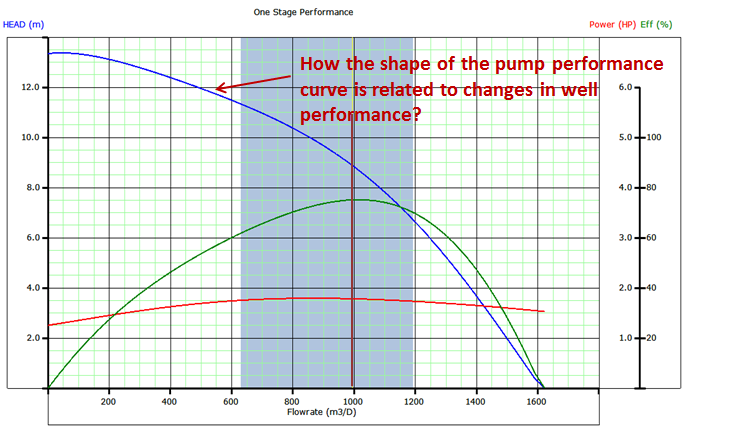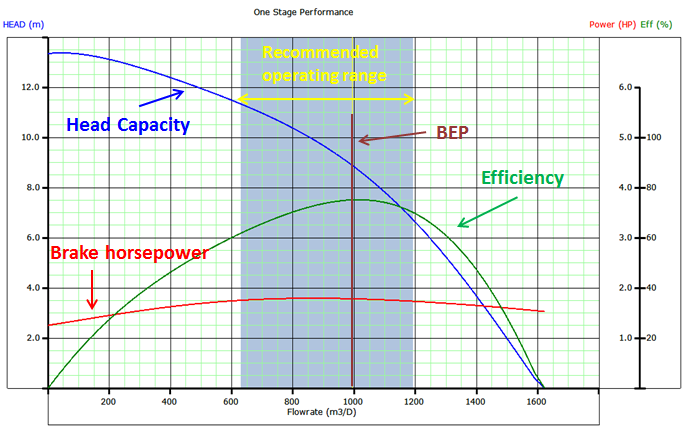| Capital cost |
· Relatively low capital cost if electric power available.
· Costs increase as horsepower increases. |
| Downhole equipment |
· Requires proper cable in addition to motor, pumps, seals, etc.
· Good design plus good operating practices are essential. |
|
Operating efficiency
(Hydraulic HP/Input HP) |
· Good for high rate wells but decreases significantly for < 1000 BFPD.
· Typically total system efficiency is about 50% for high rate wells but for < 1000 BPD, efficiency typically <40%.
· Can be as high as 60% for large ID equipment. |
| Flexibility |
· Poor for fixed speed.
· Requires careful design.
· VSD provides better flexibility. |
| Miscellaneous problems |
· Requires a highly reliable electric power system.
· System very sensitive to changes downhole or in fluid properties. |
| Operating costs |
· Varies.
· If high HP, high energy costs.
· High pulling costs result from short run life especially in offshore operation.
· Repair costs often high. |
| System reliability |
· Varies.
· Excellent for ideal lift cases.
· Poor for problem areas (very sensitive to operating temperatures and electrical malfunctions). |
| Salvage value |
· Fair.
· Some trade in value.
· Poor open market values. |
| System (Total) |
· Fairly simple to design but requires good rate data.
· System not forgiving.
· Requires excellent operating practices.
· Follow API RP’s in design, testing, and operation.
· Each well is an individual producer using a common electric system. |
| Usage/outlook |
· An excellent high rate artificial lift system.
· Best suited for <200 0F and >1000 BFPD rates.
· Most often used on high water cut wells.
· Used on about 5% of US lifted wells. |
| Casing size limits
(Restricts tubing size) |
· Casing size will limit use of large motors and pumps.
· Avoid 4.5” casing and smaller.
· Reduced performance inside 5.5” casing depending on depth and rate. |
| Depth limits |
· Usually limited to motor HP or temperature.
· Practical depth about 10,000 feet.
· 1000’ – 10000’ TVD is typical, Max is 15,000 ‘ TVD. |
| Intake capabilities
(Ability to pump with low pressures at pump intake) |
· Fair if little free gas (i.e. >250 PSI pump intake pressure).
· Poor if F = 666*(Qg/Ql)/Pip > 1.0
Where: Pip: intake psi; Qg: gas vol; Ql: liquid vol @ intake conditions.
· 5% gas at low pressures can cause problems. |
| Noise level |
· Excellent.
· Very low noise.
· Often preferred in urban areas if production rate high. |
| Obtrusiveness |
· Good.
· Low profile but requires transformer bank. |
| Prime mover flexibility |
· Fair.
· Requires a good power source without spikes or interruptions.
· Higher voltages can reduce losses. |
| Surveillance |
· Fair.
· Electrical checks but special equipment needed otherwise. |
| Relative ease of well testing |
· Good.
· Simple with few problems.
· High water cut and high rate wells may require a free water knock out (three-phase separator). |
| Time cycle and pump off controllers application |
· Poor.
· Soft start and improved seal/ protectors recommended. |
| Corrosion/scale handling ability |
· Fair.
· Batch treating inhibitor only to intake unless shroud is used. |
| Crooked/deviated holes |
· Good.
· Few problems.
· Limited experience in horizontal wells.
· Requires long radius wellbore bends to get through.
10° typical,
0 – 90° < 10° / 100 build angle maximum.
· However must set in section 0 – 2° max deviation. |
| Duals application |
· No known installations.
· Larger casing required.
· Possible run & pull problems. |
| Gas handling ability |
· Poor for free gas (i.e. >5% through pump).
· Poor if F = 666 * (Qg/Ql)/Pip > 1.0
Where: Pip: intake psi; Qg: gas vol; Ql: liquid vol, @ intake conditions.
· Rotary gas separators helpful if solids not produced. |
| Offshore application |
· Good.
· Must provide electrical power and service pulling unit. |
| Paraffin handling capability |
· Fair.
· Hot water/oil treatments, mechanical cutting, batch inhibition possible. |
| Slim hole completions
(2 7/8″ tubing, casing) |
· No known installations. |
| Solids/sand handling ability |
· Poor.
· Requires <100 – 200 PPM solids for standard construction.
· 200 – 2000 ppm possible with special bushings, stage materials, coatings, and thrust supporting bearings or fixed pumps employed.
· A maximum of about 5000 ppm might be possible depending on pump and sharpness and angularity of sand. |
| Temperature limitation |
· Limited to <2500F for standard & <4000F for special motors & cable.
· 100 – 275°F typical. |
| High viscosity fluid handling capability |
· Fair.
· Limited to as high as 1000 cp.
· Depends on economics. (~>7-9°API)
· Increases HP and reduces head.
· Potential solution is to use “core flow” with 20% water. |
| High volume lift capabilities |
· Excellent.
· Limited by needed HP and can be restricted by casing size.
· In 5.5” casing can produce 4000 BFPD from 4000 feet W/240 HP.
· Tandem motors increase HP & operating costs.
200 – 20,000 bpd typical, ~30,000 bpd max.
52,000 bpd, shallow, 10.25” equip has been done. |
| Low volume lift capabilities |
· Generally poor.
· Lower efficiencies and high operating costs <400 BFPD.
|







